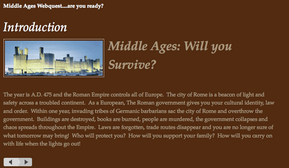
The most unique thing about this webquest is that Garth and I built an entire 6 week unit of study without ever meeting face-to-face. All of our work was done via Skype, GoogleDocs and our website. We live nearly two hours apart and we created a co-taught unit from our home offices.
There are several parts of this webquest. The traditional elements of a webquest exist; introduction, resources, tasks, etc, but we have also incorporated other elements. Garth and I recorded a series of "computer-side chats" for the introduction and most of the tasks. These podcasts are simply Garth and I talking about what the students will be researching in each task. It is a chance for our students to hear two teachers debate, discuss and analyze the information that they are researching. They also serve as mini-lectures. These podcasts are a way for Garth and I to engage students in lecture material in a digital format. We hint at answers, provide guidance, encouragement and enough foreshadowing of future tasks to help keep students interested. We also added imagery and music along the way to keep students engaged in the content. Images of castles and cathedrals, and the sound of chanting monks help create an environment that encourages empathy and inquiry in students.
Too often, teachers ask us how we assess what we do. Everybody is concerned with data. Along the way, throughout the webquest, we will use exit/entrance passes, rubrics for journal entries and weekly quizzes concerning the tasks students are completing. While these assessments will help us gauge student learning; it is important to say that they are not the main thrust for this webquest. We do not want students researching, learning and building connections just to pass a test and give us data. We want to provide an enriching learning experience that engages students and helps them develop skills that are useful in life. Our students can find information, analyze it, synthesis it, collaborate with it and construct meaningful conclusions about feudalism and the Middle Ages.
Right below this post is a short conversation between Garth and myself about how we constructed this project, some of the elements we created and our general thoughts concerning this unit of study.
-Mike
 RSS Feed
RSS Feed


